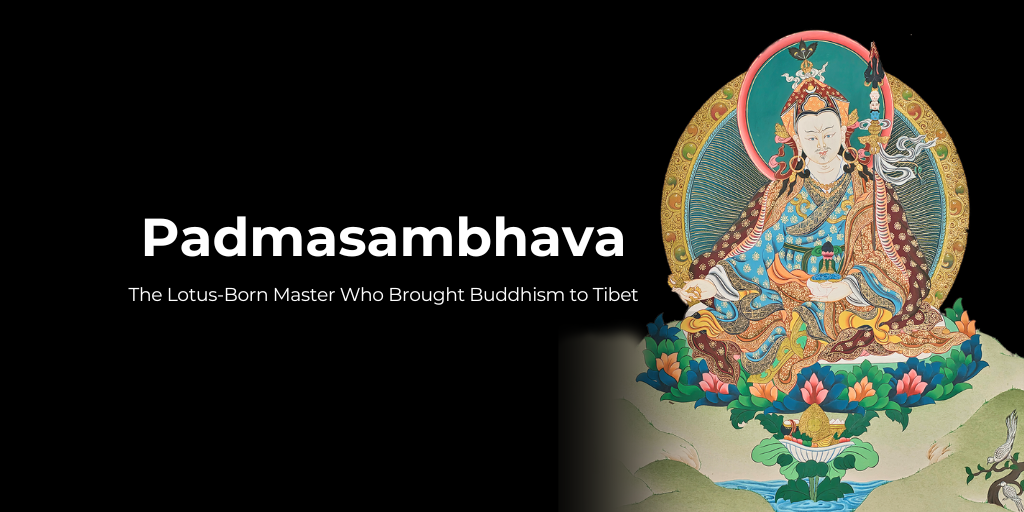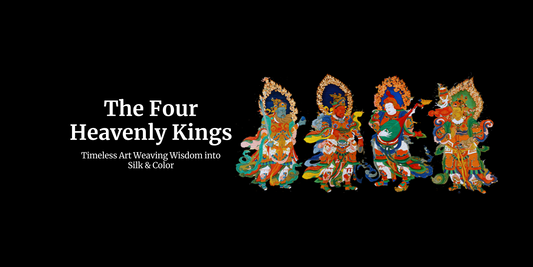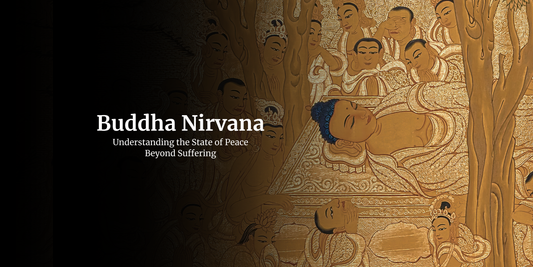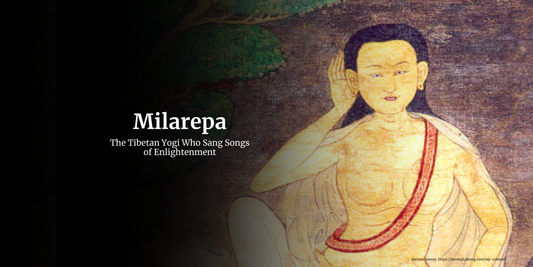- Buddhas Art of Healing
- Thangka Blog | Insights on Tibetan Thangka Art, Symbolism & Tradition
- Padmasambhava: Lotus-Born Master Who Brought Buddhism to Tibet

Padmasambhava: Lotus-Born Master Who Brought Buddhism to Tibet
In the heights of the Himalayas, one name echoes with deep respect—Padmasambhava, or Guru Rinpoche.
Known as the second Buddha, he brought Buddhism to Tibet and changed its spiritual path.
But who was he, and why is he still so deeply honored? Let’s find out why his presence continues to motivate millions.
The Miraculous Birth of Padmasambhava
Padmasambhava's origin is full of mystery and deep symbolism. According to ancient texts, it is believed that he was not born from a womb. But miraculously appeared on the lotus flower. In the middle of Dhanakosha Lake, which is considered present-day Afghanistan or Pakistan.
In Sanskrit, Padmasambhava means "lotus born". Symbolically, his lotus birth represents pure and enlightened nature, which is untouched by the ordinary world.
Though he was raised in a royal court, the young Padmasambhava was soon drawn to a deep spiritual path. He left behind comfort and luxury to carry forward intensive meditation, study, and mastery of tantric teachings.
This initial choice marked the beginning of a life filled with spiritual power and transformation.

Honor the teacher who transformed Tibet with our hand-painted, authentic Padmasambhava Thangkas.
Journey to Tibet: A Turning Point in Buddhist History
One of the most important moments in the life of Padmasambhava came in the 8th century, when he was invited by the Tibetan King Trisong Deitson. At that time, Buddhism was introduced to Tibet but was facing strong resistance from local beliefs and unseen forces.
The first Buddhist monastery, Samye Monastery, had its construction constantly interrupted. That's when Guru Padmasambhava arrived.
He used his intensive understanding of meditation and rituals. As a result, he is believed to have subdued local souls, converting them into a guardian of religion.
This powerful act allowed Buddhism to eventually take root in Tibetan soils, replacing the spiritual direction of the country forever.
Due to his extraordinary achievement, he earned a revered title, Padmasambhava Guru Rinpoche.

Bring his energy of transformation with our Padmasambhava Thangkas from Buddha's Art of Healing.
What Did Padmasambhava Teach the World?
Padmasambhava didn’t just overcome obstacles; he offered practical paths for inner transformation. His teachings, particularly those in the Vajrayana tradition, emphasized:
- The power of direct experience over mere belief
- The importance of daily practice, not just ritual
- Use of visualization, mantra, and meditation to awaken inner wisdom.
Through these teachings, he inspired thousands of people. Futhermore, his wisdom was passed on in hidden texts, called "Termas", which were to be discovered by future generations.
Bring Padmasambhava's thangka into your space, and let his wisdom inspire you.
Sacred Symbols and Visual Features of Padmasambhava
When you see a Guru Padmasambhava statue or a sacred Thangka painting, every detail carries deep spiritual meaning. In essence, these symbols help practitioners connect with his enlightened energy and teachings across time.
Below is a summary of the most important iconographic elements and their significance:
|
Symbol |
Description |
Meaning |
|
Lotus Hat |
Unique hat worn on his head |
Represents his miraculous lotus birth and divine nature |
|
Vajra (Dorje) |
Held in his right hand at heart level |
Symbolizes spiritual power, compassion, and wisdom |
|
Skull Cup (Kapala) |
Held in his left hand in meditation gesture |
Represents transformation of negative energy into wisdom |
|
Khatvanga Staff |
Resting on his left shoulder |
Signifies tantric mastery and union with his consort |
These elements are consistently present in Guru Rinpoche statues, Thangkas, and other images, thereby serving as powerful reminders of his spiritual presence and protection.

At Buddha's Art of Healing, each Padmasambhava Thangka is painted with deep devotion and detail.
The Eight Manifestations
To reach all sentient beings, Guru Rinpoche manifested in eight different forms, each expressing a unique spiritual quality:
|
Manifestation Name |
Quality or Aspect |
Representation |
|
Guru Tsokye Dorje |
Miraculous Birth |
Arises from a lotus in Lake Dhanakosha |
|
Guru Shakya Senge |
Mastery in Sutra |
Dressed as a monk, holding a begging bowl |
|
Guru Nyima Ozer |
Illuminator |
Radiates rays of sunlight to dispel ignorance |
|
Guru Padma Gyalpo |
Youthful Joy |
Appears as a princely child full of wonder |
|
Guru Loden Chokse |
Seeker of Knowledge |
Embodies scholarly wisdom |
|
Guru Senge Dradok |
Fierce Compassion |
Roars like a lion to break egoic attachments |
|
Guru Dorje Drolö |
Wrathful Liberator |
Subdues demonic forces in fierce form |
|
Guru Pema Jungné |
Teacher of Vajrayana |
Spreads tantric knowledge with compassion |
These eight manifestations are not just symbolic—they are meditative archetypes. As a result, they help practitioners to connect with Padmasambhava’s multifaceted wisdom.
With our detail-rich thangkas, connect with the many faces of Guru Rinpoche and start your spiritual journey.
The Power of the Padmasambhava Mantra
One of the most funded practices among the devotees is to recite the Padmasambwa mantra:
"Om Ah Hum Vajra Guru Padma Siddhi Hum". This holy mantra is believed to:
- Clear obstacles from your path
- Invite protection and healing
- Deepen meditation and clarity
- Strengthen your connection to Guru Rinpoche's wisdom
The mantra is not only calm but also deeply strong. Many people chant it during morning rituals, while traveling, or during difficult times.
Guru Padmasambhava Thangka: A Window into Enlightened Wisdom
A Guru Padmasambhava Thangka isn't just a painting; it is a sacred tool used in spiritual practice. Padmasambhava Thangkas are vibrant in detail and are often used for:
- Meditation and visualization
- Formal offerings
- Bless houses and temples
Traditionally, it is believed that a Padmasambhava Thangka invites knowledge, peace, and protection at home.

At Buddha's Art of Healing, each Padmasambhava thangka is designed with symbolic gestures, pigmented colors, and surroundings that reflect his spiritual power. In particular, these elements convey his transformative presence and enlightened energy.
Padmasambhava Statues in Homes and Monasteries
A Padmasambhava statue, often made of copper, bronze, or soil, is usually placed on the altars in Tibetan monasteries and houses. Moreover, his statue serves as a physical reminder of his teachings and presence.
When people keep a Padmasambhava statue in their attention, they do this with the intention of inviting their blessings in their lives. These statues are believed to:
- Provide spiritual protection
- Promotes inner peace and stability
- Encourage daily spiritual practice
Smaller Padmasambhava statues are perfect for personal use, while large ones are placed in temples or public temples.
Why does Padmasambhava matter today?
In today's fast-paced world, the timeless knowledge of Padmasambhava is more relevant than ever. His teachings remind us that there is no chaos around us; we can find peace, strength, and clarity within us.
Thanks to modern technology, high-resolution Padmasambhava images, online mantras, and thangkas are widely available. Making it easier than ever for people around the world to connect with his energy, even without visiting a monastery.
Explore our collection of Padmasambhava Thangkas from Buddha's Art of Healing, and connect with the wisdom of Guru Padmasambhava.

1. Who was Padmasambhava?
Padmasambhava, also known as Guru Rinpoche, was an 8th-century spiritual master who established Buddhism in Tibet.
2. What does the Pamasambhava mantra mean?
The mantra "Om Ah Hum Vajra Guru Padma Siddhi Hum" is a prayer for spiritual accomplishment, protection, and inner peace. It invokes the blessings of Guru Padmasambhava.
3. What is the purpose of a Guru Padmasambhava Thangka?
These sacred paintings are used for meditation, offerings, and blessing spaces. Thangkas visually represent Padmasambhava and help deepen spiritual focus.
4. How can I connect with Padmasambhava in daily life?
You can chant his mantra, meditate in front of a Thangka or statue, or read his teachings. You can also keep an image of Padmasambhava nearby to feel his guidance and protection.
Explore our hand-painted, authentic Padmasambhava Thangkas from Buddha's Art of Healing. Thangka crafted with devotion in the heart of Boudhanath.
Also, you can also connect with us on our Facebook and Instagram.



